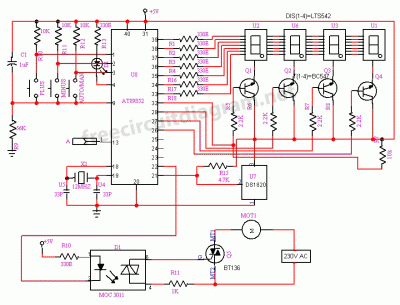
Flashing Heart circuit diagram

When power is applied to the circuit, all Red LEDs will flash on and off simultaneously. The Yellow LEDs will also flash, but only every other Yellow LED will be illuminated at any given time. The Green LEDs will remain continuously lit. The flash rate can be adjusted by turning resistor R9. Connections for a fixed value resistor for R9 are provided on the board layout if desired. Additionally, a favorite photograph can be placed in the heart area, and a frame can be constructed to fit the circuit board.
The circuit described involves a combination of Red, Yellow, and Green LEDs, each with distinct operational characteristics. The Red LEDs are configured to flash in unison, creating a visually striking effect that can be utilized for various signaling applications. The Yellow LEDs, designed to illuminate alternately, provide a unique pattern that can be employed for decorative or alert purposes. The continuous illumination of the Green LEDs serves as an indicator that the circuit is powered and operational.
The adjustable flash rate of the Red and Yellow LEDs is controlled by resistor R9. This resistor can be replaced with a potentiometer to allow for variable adjustment, enabling users to customize the flashing speed to suit their preferences or project requirements. The board layout includes provisions for soldering a fixed value resistor in place of R9, offering flexibility in circuit design.
In terms of physical design, the circuit board features an area designated for a photograph, which can enhance the aesthetic appeal of the project. A custom frame can be constructed to encase the circuit board, providing both protection and a polished appearance. This design consideration allows for creative expression while maintaining the functionality of the electronic components. Overall, this circuit presents a versatile solution for both visual signaling and decorative purposes.Once power has been applied to the circuit, the Red LEDs should all be flashing on and off together. The Yellow LEDs should be flashing on and off, but only every other Yellow LED should be on at one time. The Green LEDs will stay on at all times. The flash rate can be adjusted by turning R9. Connections for a fixed value resistor for R9 are provi ded on the board layout if preferred. To dress up the project, a favorite photograph can be placed in the heart, and a frame can be made to fit the circuit board. 🔗 External reference
The circuit described involves a combination of Red, Yellow, and Green LEDs, each with distinct operational characteristics. The Red LEDs are configured to flash in unison, creating a visually striking effect that can be utilized for various signaling applications. The Yellow LEDs, designed to illuminate alternately, provide a unique pattern that can be employed for decorative or alert purposes. The continuous illumination of the Green LEDs serves as an indicator that the circuit is powered and operational.
The adjustable flash rate of the Red and Yellow LEDs is controlled by resistor R9. This resistor can be replaced with a potentiometer to allow for variable adjustment, enabling users to customize the flashing speed to suit their preferences or project requirements. The board layout includes provisions for soldering a fixed value resistor in place of R9, offering flexibility in circuit design.
In terms of physical design, the circuit board features an area designated for a photograph, which can enhance the aesthetic appeal of the project. A custom frame can be constructed to encase the circuit board, providing both protection and a polished appearance. This design consideration allows for creative expression while maintaining the functionality of the electronic components. Overall, this circuit presents a versatile solution for both visual signaling and decorative purposes.Once power has been applied to the circuit, the Red LEDs should all be flashing on and off together. The Yellow LEDs should be flashing on and off, but only every other Yellow LED should be on at one time. The Green LEDs will stay on at all times. The flash rate can be adjusted by turning R9. Connections for a fixed value resistor for R9 are provi ded on the board layout if preferred. To dress up the project, a favorite photograph can be placed in the heart, and a frame can be made to fit the circuit board. 🔗 External reference





